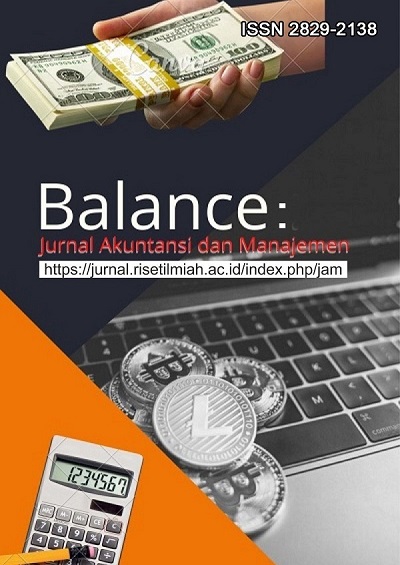Assessing the Long-Term and Short-Term Influences on Trade Value in Indonesia: Evidence from Economic, Industrial, and Monetary Factors
DOI:
https://doi.org/10.59086/jam.v3i3.608Keywords:
ECM, Trade value, Macroeconomic policy, Monetary policyAbstract
Downloads
References
Adam, P., Nusantara, A. W., & Muthalib, A. A. (2017). A Model of the Dynamic of the Relationship between Exchange Rate and Indonesia’s Export. International Journal of Economics and Financial Issues, 7(1), 255-261.
Akram, H. W., Ahmad, A., Dana, L. P., Khan, A., & Akhtar, S. (2024). Do Trade Agreements Enhance Bilateral Trade? Focus on India and Sri Lanka. Sustainability, 16(2), 582. https://doi.org/10.3390/su16020582
Alemu, A. M. (2013). The Nexus between Technological Infrastructure and Export Competitiveness of High-tech Products in East Asian Economies. Journal of Economic Development, Management, IT, Finance & Marketing, 5(1). https://www.proquest.com/scholarly-journals/nexus-between-technological-infrastructure-export/docview/1509736725/se-2?accountid=187856
Ardiyanti, S. T. (2015). The impact of real exchange rate volatility on Indonesia-US trade performance. Buletin Ilmiah Litbang Perdagangan, 9(1), 79-93.
Auboin, M., & Ruta, M. (2013). The relationship between exchange rates and international trade: a literature review. World Trade Review, 12(3), 577-605. https://doi.org/10.1017/S1474745613000025
Basuki, A. T., & Prawoto, N. (2019). Analisis Regresi: dalam Penelitian Ekonomi dan Bisni. Depok: Rajagrafindo Persada.
Breinlich, H., Leromain, E., Novy, D., & Sampson, T. (2022). Import liberalization as export destruction? evidence from the United States.
Carolina, Ţ. (2021). The Determunats of International Competitiveness. Studies in Business & Economics, 16(3). http://dx.doi.org/10.2478/sbe-2021-0058
Dang, G., & Pheng, L. S. (2015). Infrastructure investments in developing economies. Springer Science Business Media Singapore. https://doi.org/10.1007/978-981-287-248-7
Danilina, E., & Mingaleva, Z. (2014). Significance of technological innovations for an increase of competitiveness of industrial companies. Life Science Journal, 11(8s).
Đurić, D., Ristić, J., & Đurić, D. (2016). Foreign direct investments in the role of strengthening the export competitiveness of the Serbian economy. Економика пољопривреде, 63(2), 531-546. https://doi.org/10.5937/ekoPolj1602531D
Dykas, P., Tokarski, T., & Wisła, R. (2023). The Solow model of economic growth: Application to contemporary macroeconomic issues (p. 265). Taylor & Francis. https://library.oapen.org/handle/20.500.12657/76881
Foster, N., Stehrer, R., & de Vries, G. (2011). Trade in value added and factors: A comprehensive approach. Unpublished manuscript, WIOD project.
Gamariel, G., & Hove, S. (2019). Foreign direct investment and export competitiveness in Africa: Investigating the channels. Journal of African Trade, 6(1), 30-46. http://creativecommons.org/licenses/by-nc/4.0/
Idris, J., Yusop, Z., & Habibullah, M. S. (2016). Trade openness and economic growth: A causality test in panel perspective. International Journal of Business and Society, 17(2). https://doi.org/10.33736/ijbs.525.2016
Irwin, D. A. (2019). Does trade reform promote economic growth? A review of recent evidence. http://www.nber.org/papers/w25927
Ivrendi, M., & Guloglu, B. (2010). Monetary shocks, exchange rates and trade balances: Evidence from inflation targeting countries. Economic Modelling, 27(5), 1144-1155. https://doi.org/10.1016/j.econmod.2010.03.005
Johansen, S. (2014). Times Series: Cointegration.
Koopman, R., Wang, Z., & Wei, S. J. (2008). How much of Chinese exports is really made in China? Assessing domestic value-added when processing trade is pervasive (No. w14109). National Bureau of Economic Research. http://www.nber.org/papers/w14109
Mankiw, N. G., & Taylor, M. P. (2020). Economics. Cengage Learning EMEA.
Nguyen, A. T. (2022). The relationship between economic growth, foreign direct investment, trade openness, and unemployment in South Asia. Asian Academy of Management Journal, 27(2), 21-40. https://www.proquest.com/scholarly-journals/relationship-between-economic-growth-foreign/docview/2760738439/se-2?accountid=187856
Ogah, A. O., Nkwede, J. O., & Alita, E. C. (2024). Effect of Economic Globalization on Agricultural Bang for the Buck in China and Indonesia. In Developing Digital Inclusion Through Globalization and Digitalization (pp. 107-141). IGI Global. http://orcid.org/0000-0001-9152-1773
Okpe, A. E., & Ikpesu, F. (2021). Effect of inflation on food imports and exports. The Journal of Developing Areas, 55(4), 1-10. https://doi.org/10.1353/jda.2021.0075
Onuorah, A. C. (2018). Role of non-oil exports in the economic growth of Nigeria. Journal of Emerging Trends in Economics and Management Sciences, 9(3), 132-140. https://hdl.handle.net/10520/EJC-11e392bca2
Pan, X., Zhang, J., Li, C., Quan, R., & Li, B. (2018). Exploring Dynamic Impact of Foreign Direct Investment on China’s CO 2 Emissions Using Markov-Switching Vector Error Correction Model. Computational Economics, 52(4), 1139-1151. https://link.springer.com/article/10.1007/s10614-017-9745-x
Rahmaddi, R., & Ichihashi, M. (2012). How do foreign and domestic demand affect exports performance? An econometric investigation of Indonesia’s exports. Modern Economy, 3(1), 32-42. http://dx.doi.org/10.4236/me.2012.31005
Rahmaddi, R., & Ichihashi, M. (2012). The impact of foreign direct investment on host country's exports: Sector-based evidence from Indonesian manufacturing. IDEC DP2 Series, 2(10), 1-29. https://hiroshima.repo.nii.ac.jp/records/2015593
Sahoo, M., & Sethi, N. (2020). Impact of industrialization, urbanization, and financial development on energy consumption: Empirical evidence from India. Journal of public affairs, 20(3), e2089. https://doi.org/10.1002/pa.2089
Sahoo, M., & Sethi, N. (2023). An empirical insight into the financial globalization–growth nexus via trade openness: Evidence from select south Asian countries. Global Business Review, 24(2), 317-334. https://doi.org/10.1177/0972150919893840
Sandee, H. (2016). Improving connectivity in Indonesia: The challenges of better infrastructure, better regulations, and better coordination. Asian Economic Policy Review, 11(2), 222-238. https://doi.org/10.1111/aepr.12138
Shiferaw, A. (2017). Productive capacity and economic growth in Ethiopia. United Nations, Department of Economics and Social Affairs.
Shinyekwa, I., & Ntale, A. (2017). The role of economic infrastructure in promoting exports of manufactured products: Trade facilitation and industrialization in the EAC. http://dx.doi.org/10.22004/ag.econ.265773
Smyth, R., & Narayan, P. K. (2015). Applied econometrics and implications for energy economics research. Energy Economics, 50, 351-358. https://doi.org/10.1016/j.eneco.2014.07.023
Sun, P., & Heshmati, A. (2010). International trade and its effects on economic growth in China (No. 5151). IZA Discussion Papers. https://hdl.handle.net/10419/46020
Tan, K. G., Trieu Duong, L. N., & Chuah, H. Y. (2019). Impact of exchange rates on ASEAN's trade in the era of global value chains: An empirical assessment. The Journal of International Trade & Economic Development, 28(7), 873-901. https://doi.org/10.1080/09638199.2019.1607532
Thuy, V. N. T., & Thuy, D. T. T. (2019). The impact of exchange rate volatility on exports in Vietnam: A bound testing approach. Journal of Risk and Financial Management, 12(1), 6. https://doi.org/10.3390/jrfm12010006
Umeaduma, C. M. G., & Dugbartey, A. N. (2023). Effect of Exchange Rate Volatility on Export Competitiveness and National Trade Balances in Emerging Markets. Int J Comput Appl Technol Res, 12(11), 57-71. https://doi.org/10.7753/IJCATR1211.1008
Xie, Y. D., & Baek, Y. (2020). Impact of exchange rate and firm heterogeneity on exports. Journal of Southeast Asian Economies, 37(2), 199-223. https://www.proquest.com/scholarly-journals/impact-exchange-rate-firm-heterogeneity-on/docview/2681902215/se-2?accountid=187856
Zahonogo, P. (2016). Trade and economic growth in developing countries: Evidence from sub-Saharan Africa. Journal of African Trade, 3(1-2), 41-56. https://doi.org/10.1016/j.joat.2017.02.001
Downloads
Published
How to Cite
Issue
Section
License
Copyright (c) 2024 Agus Tri Basuki

This work is licensed under a Creative Commons Attribution 4.0 International License.
This is an open-access journal. All works are published under the Creative Commons license CC-BY which means that all content is freely available at no charge to the user or his/her Institution. Users are allowed to read, download, copy, write, improve, and create derivative creation even for other lawful purposes, this license permits anyone to, as long as they cite and license the derivative creation under similar terms

This work is licensed under a Creative Commons Attribution 4.0 International License.
Most read articles by the same author(s)
- Agus Tri Basuki, ASEAN Economic Growth: The Influence of Inflation, Trade, and Industrial Policy , Balance : Jurnal Akuntansi dan Manajemen: Vol. 4 No. 1 (2025): April 2025
- Agus Tri Basuki, The The Long- and Short-Run Effects of GDP, Labor Force, and Industrial Growth on Unemployment in Indonesia , Balance : Jurnal Akuntansi dan Manajemen: Vol. 3 No. 2 (2024): Agustus 2024


















